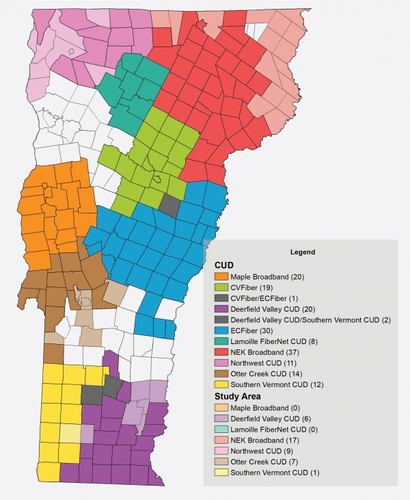HALIFAX — Six southern Vermont communities with poor - or no - internet could have access to high-speed service by next year, as negotiations are in progress for a vendor to provide broadband to some of the most analog towns in the region.
Efforts to bring reliable and affordable communications to the far-flung hills got a big assist in recent days, when a Covid relief bill became law, distributing $3.2 million in state aid from the federal American Rescue Plan to the state's broadband efforts.
Rep. Laura Sibilia, I-Dover, said the possibility of Windham County's more rural areas finally having access to broadband is exciting.
“Regular Vermonters did that,” she said.
According to the website of the Deerfield Valley Communications Union District - known primarily by its trade name, DVFiber - 80 percent of Vermonters subscribe to an internet provider, yet the state ranks 43rd in the nation as far as network speeds.
In 2015, the state authorized the creation of Communications Union Districts (CUDs), community-level municipalities structured similarly to school districts or solid waste districts. In 2019, the Legislature provided the state's CUDs with funding to support planning and provide technical assistance.
As of April 20, the Department of Public Service lists nine CUDs serving the state.
DVFiber's member towns include Brattleboro, Dover, Dummerston, Guilford, Halifax, Jamaica, Londonderry, Marlboro, Newfane, Putney, Readsboro, Searsburg, Stamford, Stratton, Vernon, Wardsboro, Westminster, Weston, Whitingham, Wilmington, Windham, and Winhall.
Sibilia said it appears that Gov. Phil Scott is in favor of the CUD model. She added that while the federal money represents a boon to the CUDs, a lot of volunteer hours have gotten communities to a place where they are ready to launch projects.
RFPs are in for first six towns
Halifax, Marlboro, Stamford, Readsboro, Whitingham, and Wardsboro are part of DVFiber's first phase of rolling out internet according to the organization's request for proposals (RFP).
The 20 towns that comprised DVFiber when the RFP was written had a total population of 36,432 in 2019. Of the buildings served, 36 percent are homesteads, or primary residences, with the rest a combination of second homes and commercial properties.
The Vermont Department of Public Service has identified 7,341 residences that lack broadband speeds of at least 25 Mbps (megabits per second) for downloads and 3 Mbps for uploads.
In the six phase-one towns, an estimated 4,089 premises are considered “uncabled.”
From five towns to 21
DVFiber launched in 2020 with five towns in the Deerfield Valley with the goal of providing “affordable, reliable high-speed internet service” within the district. It has since expanded to 21 towns across three counties - Windham, Bennington, and Windsor.
On its website, the DVCUD outlines its goal: to open the way for broadband infrastructure and providing service to underserved areas. The DVCUD has begun its negotiation phase with potential internet providers.
Last month, DVCUD received nearly a dozen RFPs from companies located across the U.S. DVCUD expects negotiations to take approximately six weeks.
If successful, a public-private partnership will emerge from the conversations. On behalf of its member towns, the vendor will design, build, and operate the new network. Subscriber fees will subsidize its operation and maintenance.
In its RFP, DVFiber outlined for potential private partners the speed levels and pricing tiers it expects for subscribers. A board of directors set up by the CUD will oversee the eventual partnership. According to the RFP, the network provider will share a percentage of profits with the board, with the percentage to be negotiated.
On the CUD's website are hints at Vermont's unsuccessful-at-times experience with previous attempts at solving the problem of rural internet coverage. DVFiber's priorities include reliable and affordable service as well as technology that evolves with the industry.
Service implementation will prioritize towns that currently have little to no high-speed internet. The network must be capable of “at least gigabit-per-second service to all fixed locations,” with room for additional capacity and flexibility as they become available, according to the website.
In its April newsletter, DVFiber board members noted that the planning process has gone well. For example, the Windham Regional Commission completed a business plan for the organization last summer.
Broadband funds in Covid bill
Obtaining early financing to build the new network has been difficult. Board members encouraged residents to urge their state elected officials to authorize the use of federal Covid relief funding for broadband.
“Regardless of what bills end up being passed into law, it is apparent that the urgent need for rural broadband expansion and the opportunity at hand with stimulus funds are going to result in federally funded Internet expansion in Vermont,” the board wrote in the DVFiber newsletter.
“The funds being discussed have the potential to expedite our rollout of fiber to our member towns and make DVFiber financially sustainable much sooner than originally envisioned.”
On Saturday, Gov. Phil Scott allowed a $104 million state COVID-19 aid bill to become law without his signature.
Scott said he was concerned that lawmakers wanted to use money from the recently-approved American Rescue Plan Act (ARPA) to fund the state recovery spending package. He also expressed his preference to allocate the federal money in one bill.
Last month, he proposed a $1 billion plan to use the federal aid for broadband expansion, affordable housing, and climate change measures.
Scott said that he did not believe his objections to the Legislature's approach justified a veto.
“Because this bill contains urgently needed funds for Vermonters, I am allowing it to become law,” the governor wrote. “But the Legislature should note that I will not support any additional, unnecessary, or unwise use [of federal monies].”
